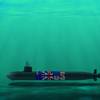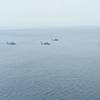U.S. Snub on Cutter Funds Seen as Threat
The Obama administration’s failure to budget $1.6 billion for two of the Coast Guard’s flagship vessels is drawing criticism from U.S. lawmakers, who contend that the service’s missions will be threatened.
The Department of Homeland Security’s proposal for the fiscal year, beginning October1, requests $683 million to fund only the sixth of eight planned National Security Cutters, made by Huntington Ingalls Industries Inc. The agency, which oversees the Coast Guard, didn’t seek funding for the remaining two cutters for fiscal years 2014 to 2017.
The 418-foot-long cutters are needed to replace an aging fleet of vessels, many of which are more than 40 years old and expensive to maintain, according to the service. The older ships also aren’t equipped for some of the Coast Guard’s missions, which expanded after the service moved in 2003 from the Department of Transportation to Homeland Security, created following the September 11 attacks.
“I’m very concerned that the department’s budget is spreading our maritime resources too thin,” Representative Chip Cravaack, a Minnesota Republican, said in an interview after a March 7 hearing of the House Transportation and Infrastructure’s Coast Guard subcommittee. “This puts our nation at risk.”
The Coast Guard, more than two centuries old, had 38,000 active-duty men and women, 8,000 reservists and 35,000 auxiliary personnel in 2010, according to its website. The service defines a cutter as any ship more than 65 feet long and with space for the crew to live on board.
Shipbuilder Huntington, spun off from Northrop Grumman Corp. a year ago, has received contracts to build the first four new cutters and was awarded the fifth in September, according to the Coast Guard website. Three of the six cutters are in service, the last of which was commissioned in September.
The largest builder of Navy surface warships, Newport News, Virginia-based Huntington depends on the U.S. government for “substantially all” of its revenue, the company said.
Huntington had $6.58 billion in estimated revenue in the 12 months ended September 30, 2011, according to data compiled by Bloomberg. Its shares rose $1.16, or 3.2 percent, to close at $37.46 Friday in New York Stock Exchange composite trading.
About 1,000 people work in the National Security Cutter program, Bill Glenn, a Huntington spokesman, said in an e-mail. He declined to comment on what might happen to those workers if the project doesn’t receive future funding.
Whether the two cutters receive funding remains in doubt, Coast Guard Commandant Admiral Robert Papp said in a March 6 interview, after testifying before the House Appropriations subcommittee on Homeland Security.
“Each and every year we will have to do an assessment of what we can afford,” he said.
President Barack Obama’s proposed budget reduces the Coast Guard’s total funding by 5.7 percent in fiscal 2013, to $9.97 billion, from the $10.6 billion, enacted in fiscal 2012. The service’s capital budget would decline 19 percent, according to budget documents.
“Congress has never supported a plan which so bluntly guts operational capabilities,” Representative Robert Aderholt, an Alabama Republican and chairman of the Appropriations subcommittee on Homeland Security, said at the hearing. “I believe what is at stake is no less than the future of our Coast Guard.”
The Coast Guard’s budget is able to meet the service’s needs, given the constraints of the U.S. budget deficit, Homeland Security Secretary Janet Napolitano testified March 8 at a hearing of the Senate Appropriations subcommittee on Homeland Security.
Lawmakers from both parties disagreed.
“I have strong reservations about the inadequate funding requests to replace aging Coast Guard ships and planes,” Senator Mary Landrieu, a Louisiana Democrat and chairwoman of the Appropriations subcommittee on Homeland Security, said at the March 8 hearing. “I will work with my colleagues to identify resources to restore those cuts.”
The new National Security Cutter is the largest and most technically advanced ship the Coast Guard has ever commissioned, according to its website. The vessel replaces the 378-foot Hamilton Class High Endurance Cutters, first built in the 1960s. The new cutter is faster and can operate farther from shore, the website says.
The Coast Guard’s mission has expanded beyond U.S. shores to include drug enforcement, terrorism prevention, and environmental protection in the Arctic, South America, Mexico and the Caribbean. The service’s goal is to detect and deter threats to the nation, and the National Security Cutter plays an important role in those efforts, Papp said in the interview.
While the new cutter performs traditional Coast Guard duties, such as search and rescue, it’s also equipped to detect and defend against chemical, biological and radiological attacks.
The service may face additional burdens as the Navy reevaluates its fleet size and patrol commitments, Papp told the House Appropriations Homeland Security subcommittee March 6. The Navy’s Perry-class frigates, for example, are leaving service, and those warships are critical to counter-drug missions, he said.
The Department of Homeland Security’s budget request for fiscal 2012 was for $795 million in fiscal 2014 and $853 million the following year for the two cutters. The entire National Security Cutter program is estimated to cost $4.75 billion through 2018, according to budget documents.
The U.S. Government Accountability Office, Congress’s investigative arm, found that figure to be conservative. In a July report, it put the cost of the eight cutters at about $5.6 billion, or 19 percent higher than budgeted.
The budget request for fiscal 2013 also included $860 million through fiscal 2017 to build a polar icebreaker, a ship capable of plowing through ice-filled waterways. The U.S. currently has only one medium-size icebreaker.
Funding for cutters must be provided in multiple budget years to keep the production line going, said Thad Allen, a former Coast Guard commandment who is now a vice president at Booz Allen Hamilton, the McLean, Virginia-based government contractor. This allows equipment to be purchased and personnel hired for the next stage of development, he said.
“Since there was no money in this budget, the production line is broken,” Allen said in a March 9 interview. “No one has said that the cutter program is terminated. But, without the money, and particularly because they did fund the ice breaker, it essentially is.” (Bloomberg)










